Energy Management of Combined Cooling, Heating and Power Micro Energy Grid Based on Leader-Follower Game Theory
Abstract
:1. Introduction
- An innovative dynamic leader-follower game is proposed in this paper to balance the interactions between MEG and user; moreover, different from Pareto front obtained by the traditional multi-objective optimization, the Nash equilibrium (NE) here that provides optimal solutions is proven to exist uniquely.
- The proposed analytical method accommodates both the individual rationality and activity of participants in the decision-making process, and resolves the conflict between different stakeholders.
- In the process of game optimization, the multi-energy needed on the user side are fully considered and used as optimization variables.
- The user dissatisfaction function is proposed, which is characterized as the inherent relationship between the actual load and the demand load.
- The user’s expenditure and dissatisfaction are quantified in the fuzzy bi-objective algorithm, which makes the user objective function more reasonable.
2. The Modeling of MEG
2.1. The Balance in Energy Bus
- Electrical balance
- Heating balance
- Cooling balance
2.2. Device Output Constraints
2.3. Constraints for Energy Storage Devices
3. Leader-Follower Game between MEG and User
3.1. The Basic Idea of the Game
- Participants
- Strategies
- Profit/Payment function
3.2. Profit Function of the MEG
3.3. Payment Function of the User
- Before reaching the user demand load, the larger the actual load reduction ratio is, the higher the dissatisfaction is.
- When reaching the demand load, the dissatisfaction becomes zero.
- When the actual load exceeds the demand load, the dissatisfaction becomes negative, which means that it becomes satisfaction.
- However, the user satisfaction cannot increase indefinitely with the increase of the actual load. When the actual load increases to a certain extent, the change of user satisfaction tends to be slow and close to a preset value.
- Step 1: Solve the optimization problem with only expenditure objective. Get the optimal expenditure Pm, and calculate the user dissatisfaction in this condition, noted as RM.
- Step 2: Solve the optimization problem with only dissatisfaction objective. Get the optimal dissatisfaction Rm, and calculate the expenditure in this condition, noted as PM.
- Step 3: Fuzz the objective function value and establish the mapping from single objective function value to membership degree. The membership degree function in this paper is a semi-trapezoidal distribution: the membership degree equals 1 when P < Pm, and it equals 0 when P > PM (the same as R). When Pm < P < PM and Rm < R < RM, the membership degree is a linear distribution. The two membership degree functions are shown in Equations (23) and (24).
- Step 4: Add the weighted membership degree functions linearly, and then the fuzzy bi-objective function can be obtained. According to the principle of maximizing membership degree, the fuzzy bi-objective function is taken as the payment function of the user to be optimized in the game.
3.4. Nash Equilibrium
3.5. Game Solving Process
4. Case Study
4.1. Simulation Settings
4.2. Optimal Results Analysis in Different Scenarios
- The optimal results in Scenario 1
- The optimal results in Scenario 2
- The optimal results in Scenario 3
5. Conclusions
Acknowledgments
Author Contributions
Conflicts of Interest
Nomenclature
| Indices | |
| t | period |
| m | m-type device |
| n | n-type device |
| k | k-type device |
| i | i-type device |
| Sets | |
| G | set of participants |
| Ω | set of strategies |
| Ωpr | set of energy sales prices |
| Ωl | set of loads |
| Parameters | |
| Ein,max | maximum charge rate per unit time |
| Eout,max | maximum discharge rate per unit time |
| Jg | natural gas price, ¥/m3 |
| Je | electricity price of the grid, ¥/kWh |
| Ki | maintenance cost factor for i-type device, ¥/kW |
| pemi | emission price of gas, ¥/m3 |
| wgasC | CO2 emission volume of gas consumed, m3/kWh |
| wgasN | NOx emission volume of gas consumed, m3/kWh |
| welcC | CO2 emission volume of electricity purchased from the grid, m3/kWh |
| welcN | NOx emission volume of electricity purchased from the grid, m3/kWh |
| δ | penalty price, ¥/kWh |
| α | related to the magnitude of function R |
| β | preset value that the function R close to when the actual load increases to a certain extent |
| λ | related to the proportional elasticity of load adjustment |
| dt | user’s demand load, kW |
| a | weight coefficient of objective P |
| b | weight coefficient of objective R |
| ν | maximum interruptible load ratio |
| lt,un | uninterruptible load, kW |
| Functions | |
| IMEG | profit of MEG, ¥ |
| Iuser | payment function of the user |
| Ct | production cost of MEG, ¥ |
| Emit | emission cost of MEG, ¥ |
| ρ | punishment fee, ¥ |
| P | energy-purchasing expenditure, ¥ |
| R | user dissatisfaction function |
| Variables | |
| Pgrid,t | exchange power between the electrical bus and the power grid in period t, kW |
| Ppv,t | power output of PV in period t, kW |
| Pwt,t | power output of WT in period t, kW |
| Pce,t | power output of internal combustion engine in period t, kW |
| Pch,t | electricity consumption while chiller working in period t, kW |
| Pice,t | electricity consumption while ice-storage air-conditioner making ice in period t, kW |
| Pmelt,t | electricity consumption while ice-storage air-conditioner melting ice in period t, kW |
| Icc,t | status value of ice-storage air-conditioner making ice in period t |
| Icd,t | status value of ice-storage air-conditioner melting ice in period t |
| Sbad,t | discharging power of battery storage in period t, kW |
| Sbac,t | charging power of battery storage in period t, kW |
| Ibad,t | status value of battery storage discharging in period t |
| Ibac,t | status value of battery storage charging in period t |
| Le,t | actual electrical load consumed by the user in period t, kW |
| Hce,t | heating output of heat exchanger in period t, kW |
| Hdf,t | heating output of direct-fired absorption chiller in period t, kW |
| Shd,t | heating discharging power of thermal storage in period t, kW |
| Shc,t | heating charging power of thermal storage in period t, kW |
| Ihd,t | status value of thermal storage discharging in period t |
| Ihc,t | status value of thermal storage charging in period t |
| Lh,t | actual heating load consumed by the user in period t, kW |
| Cdf,t | cooling output of direct-fired absorption chiller in period t, kW |
| Cch,t | cooling output of chiller in period t, kW |
| Cice,t | cooling output of ice-storage air-conditioner in period t, kW |
| Lc,t | actual cooling load consumed by the user in period t, kW |
| Ein,t | energy storage rate in period t |
| Eout,t | energy release rate in period t |
| SOCt | state of charging of the energy storage device in period t |
| prt | energy sales prices of MEG in period t, ¥/kWh |
| lt | actual loads consumed by the user in period t, kW |
| Vg,t | total gas volume consumed by MEG in period t, m3 |
| Pi,t | output power of the i-type device in period t, kW |
| gre | total generating capacity of renewable energy in period t, kW |
| Abbreviations | |
| MEG | micro energy grid |
| NE | Nash equilibrium |
| CCHP | combined cooling, heating and power |
| PV | photovoltaic |
| WT | wind turbines |
| PSO | particle swarm optimization |
| CE | combustion engine |
| CH | chiller |
| ICE | ice-storage air-conditioner |
| DF | direct-fired absorption chiller |
| RTP | real-time electricity price |
| TOU | time of use price |
| HP | heating price |
| CDF | cooling capacity of direct-fired absorption chiller |
| HDF | heating capacity of direct-fired absorption chiller |
| BSD | battery storage discharges |
| BSC | battery storage charges |
| ISC | ice storage device charges |
| ISD | ice storage device discharges |
| HSD | heating storage device discharges |
| HSC | heating storage device charges |
| ICEM | ice-storage air-conditioner melts ice |
| EL | electrical load |
| HL | heating load |
| CL | cooling load |
References
- Rifkin, J. The Third Industrial Revolution. Eng. Technol. 2012, 6, 8–11. [Google Scholar] [CrossRef]
- Mei, S.; Li, R.; Xue, X.; Chen, Y.; Lu, Q.; Chen, X.; Carsten, D.A.; Li, R.; Chen, L. Paving the Way to Smart Micro Energy Grid: Concepts, Design Principles, and Engineering Practices. CSEE J. Power Energy Syst. 2017, 3, 440–449. [Google Scholar]
- Goldstein, L.; Hedman, B.; Knowles, D.; Freedman, S.I.; Woods, R.; Schweizer, T. Gas-Fired Distributed Energy Resource Technology Characterizations; National Renewable Energy Lab. Technic Report; National Renewable Energy Lab.: Golden, CO, USA, 2003. [Google Scholar] [CrossRef]
- Piacentino, A.; Cardona, F. On Thermoeconomics of Energy Systems at Variable Load Conditions: Integrated Optimization of Plant Design and Operation. Energy Convers. Manag. 2007, 48, 2341–2355. [Google Scholar] [CrossRef]
- Siddiqui, A.S.; Firestone, R.M.; Ghosh, S.; Stadler, M.; Edwards, J.L.; Marnay, C. Distributed Energy Resources Customer Adoption Modeling with Combined Heat and Power Applications. Off. Sci. Tech. Inf. Tech. Rep. 2003, 3, 322–330. [Google Scholar]
- Bao, Z.; Zhou, Q.; Yang, Z.; Yang, Q.; Xu, L.; Wu, T. A Multi Time-Scale and Multi Energy-Type Coordinated Microgrid Scheduling Solution—Part I: Model and Methodology. IEEE Trans. Power Syst. 2015, 30, 2257–2266. [Google Scholar] [CrossRef]
- Wang, C.; Yang, X.; Wu, Z.; Che, Y.; Guo, L.; Zhang, S.; Liu, Y. A Highly Integrated and Reconfigurable Microgrid Testbed with Hybrid Distributed Energy Sources. IEEE Trans. Smart Grid 2016, 7, 451–459. [Google Scholar] [CrossRef]
- Ma, T.; Wu, J.; Hao, L. Energy Flow Modeling and Optimal Operation Analysis of the Micro Energy Grid Based on Energy Hub. Energy Convers. Manag. 2017, 133, 292–306. [Google Scholar] [CrossRef]
- Li, D.; Wu, J.; Lin, K.; Gong, T.; Du, C.; Liu, D. Research on Optimization of Multi Energy-Type Coordinated Microgrid Considering User Satisfaction. In Proceedings of the 2017 IEEE Conference on Energy Internet and Energy System Integration (EI2), Beijing, China, 26–28 November 2017. [Google Scholar]
- Solanki, B.V.; Raghurajan, A.; Bhattacharya, K.; Cañizares, C.A. Including Smart Loads for Optimal Demand Response in Integrated Energy Management Systems for Isolated Microgrids. IEEE Trans. Smart Grid 2017, 8, 1739–1748. [Google Scholar] [CrossRef]
- Piacentino, A.; Cardona, F. EABOT–Energetic Analysis as a Basis for Robust Optimization of Trigeneration Systems by Linear Programming. Energy Convers. Manag. 2008, 49, 3006–3016. [Google Scholar] [CrossRef]
- Gimelli, A.; Luongo, A.; Muccillo, M. Efficiency and Cost Optimization of a Regenerative Organic Rankine Cycle Power Plant through the Multi-Objective Approach. Appl. Therm. Eng. 2016, 114, 601–610. [Google Scholar] [CrossRef]
- Marzband, M.; Azarinejadian, F.; Savaghebi, M.; Guerrero, J.M. An Optimal Energy Management System for Islanded Microgrids Based on Multiperiod Artificial Bee Colony Combined with Markov Chain. IEEE Syst. J. 2017, 11, 1712–1722. [Google Scholar] [CrossRef]
- Wang, S.; Su, L.; Zhang, J. MPI Based PSO Algorithm for The Optimization Problem in Micro-grid Energy Management System. In Proceedings of the 2017 Chinese Automation Congress (CAC), Jinan, China, 20–22 October 2017. [Google Scholar]
- Bao, Z.; Zhou, Q.; Yang, Z.; Yang, Q.; Xu, L.; Wu, T. A Multi Time-Scale and Multi Energy-Type Coordinated Microgrid Scheduling Solution—Part II: Optimization Algorithm and Case Studies. IEEE Trans. Power Syst. 2015, 30, 2267–2277. [Google Scholar] [CrossRef]
- Gimelli, A.; Muccillo, M.; Sannino, R. Optimal Design of Modular Cogeneration Plants for Hospital Facilities and Robustness Evaluation of the Results. Energy Convers. Manag. 2017, 134, 20–31. [Google Scholar] [CrossRef]
- Gimelli, A.; Muccillo, M.; Sannino, R. Effects of Uncertainties on the Stability of the Results of an Optimal Sized Modular Cogeneration Plant. Energy Procedia 2017, 126, 369–376. [Google Scholar] [CrossRef]
- Azizivahed, A.; Naderi, E.; Narimani, H.; Fathi, M.; Narimani, M.R. A New Bi-Objective Approach to Energy Management in Distribution Networks with Energy Storage Systems. IEEE Trans. Sustain. Energy 2018, 9, 56–64. [Google Scholar] [CrossRef]
- Zhou, Z.; Bai, J.; Sheng, Z. A Stackelberg Game Approach for Energy Management in Smart Distribution Systems with Multiple Microgrids. In Proceedings of the 2015 IEEE Twelfth International Symposium on Autonomous Decentralized Systems, Taichung, Taiwan, 25–27 March 2015. [Google Scholar]
- Asimakopoulou, G.E.; Dimeas, A.L.; Hatziargyriou, N.D. Leader-Follower Strategies for Energy Management of Multi-Microgrids. IEEE Trans. Smart Grid 2013, 4, 1909–1916. [Google Scholar] [CrossRef]
- Chen, J.; Zhu, Q. A Stackelberg Game Approach for Two-Level Distributed Energy Management in Smart Grids. IEEE Trans. Smart Grid 2017. [Google Scholar] [CrossRef]
- Lu, T.; Wang, Z.; Wang, J.; Ai, Q.; Wang, C. A Data-Driven Stackelberg Market Strategy for Demand Response-Enabled Distribution Systems. IEEE Trans. Smart Grid 2018. [Google Scholar] [CrossRef]
- Wei, F.; Wu, P.Z.; Wu, Q.H.; Jing, Z.X. A Stackelberg Game Approach for Multiple Energies Trading in Integrated Energy Systems. Appl. Energy 2017, 200, 315–329. [Google Scholar] [CrossRef]
- Han, K.; Lee, J.; Choi, J. Evaluation of Demand-Side Management over Pricing Competition of Multiple Suppliers Having Heterogeneous Energy Sources. Energies 2017, 10, 1342. [Google Scholar] [CrossRef]
- Yu, M.; Hong, S.H. Incentive-Based Demand Response Considering Hierarchical Electricity Market: A Stackelberg Game Approach. Appl. Energy 2017, 203, 267–279. [Google Scholar] [CrossRef]
- Liang, Y.; Liu, F.; Wang, C.; Mei, S. Distributed Demand-Side Energy Management Scheme in Residential Smart Grids: An Ordinal State-Based Potential Game Approach. Appl. Energy 2017, 206, 991–1008. [Google Scholar] [CrossRef]
- Yu, Y.; Jin, T.; Zhong, C. Designing an Incentive Contract Menu for Sustaining the Electricity Market. Energies 2015, 8, 14197–14218. [Google Scholar] [CrossRef]
- Wang, C.; Hong, B.; Li, G.; Zhang, D.; Liu, W. A General Modeling Method for Optimal Dispatch of Combined Cooling, Heating and Power Microgrid. Proc. CSEE 2013, 33, 26–33. [Google Scholar]
- Myerson, R.B. Game Theory: Analysis of Conflict; Harvard University Press: Cambridge, MA, USA, 1997. [Google Scholar]
- Başar, T.; Olsder, G.J. Dynamic Noncooperative Game Theory; Academic Press: London, UK, 1995. [Google Scholar]
- Yang, P.; Tang, G.; Nehorai, A. A Game-Theoretic Approach for Optimal Time-of-Use Electricity Pricing. IEEE Trans. Power Syst. 2013, 28, 884–892. [Google Scholar] [CrossRef]
- Zhang, N.; Zhou, Y.; Yao, M.; Zhang, J.; Cong, X.; Xiao, X. A Fuzzy Bi-Objective Unit Commitment Model Considering Source-Grid-Load Interactions. In Proceedings of the 2013 IEEE PES Asia-Pacific Power and Energy Engineering Conference (APPEEC), Kowloon, China, 8–11 December 2013. [Google Scholar]
- Nash, J. Non-Cooperative Games. Ann. Math. 1951, 54, 286–295. [Google Scholar] [CrossRef]

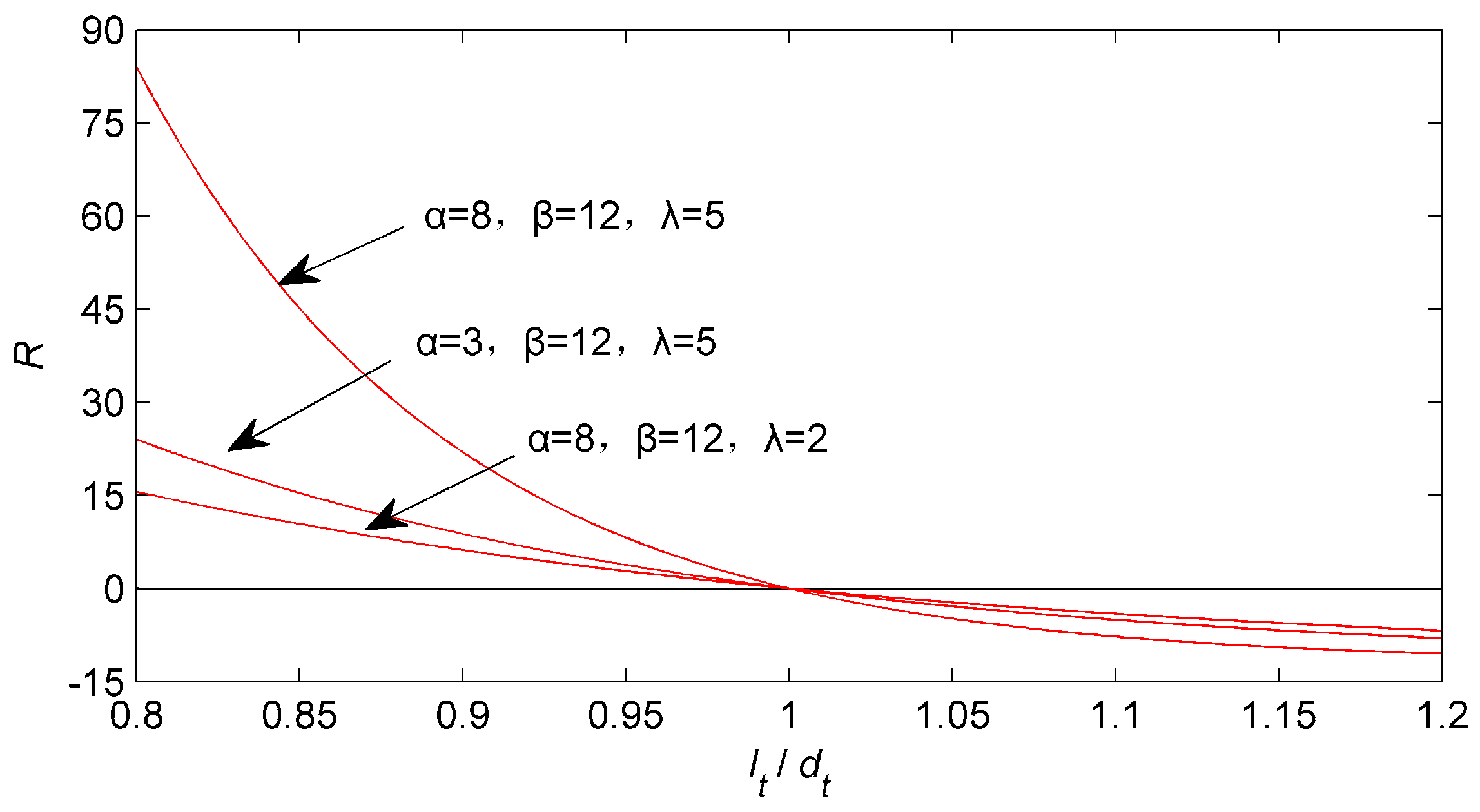
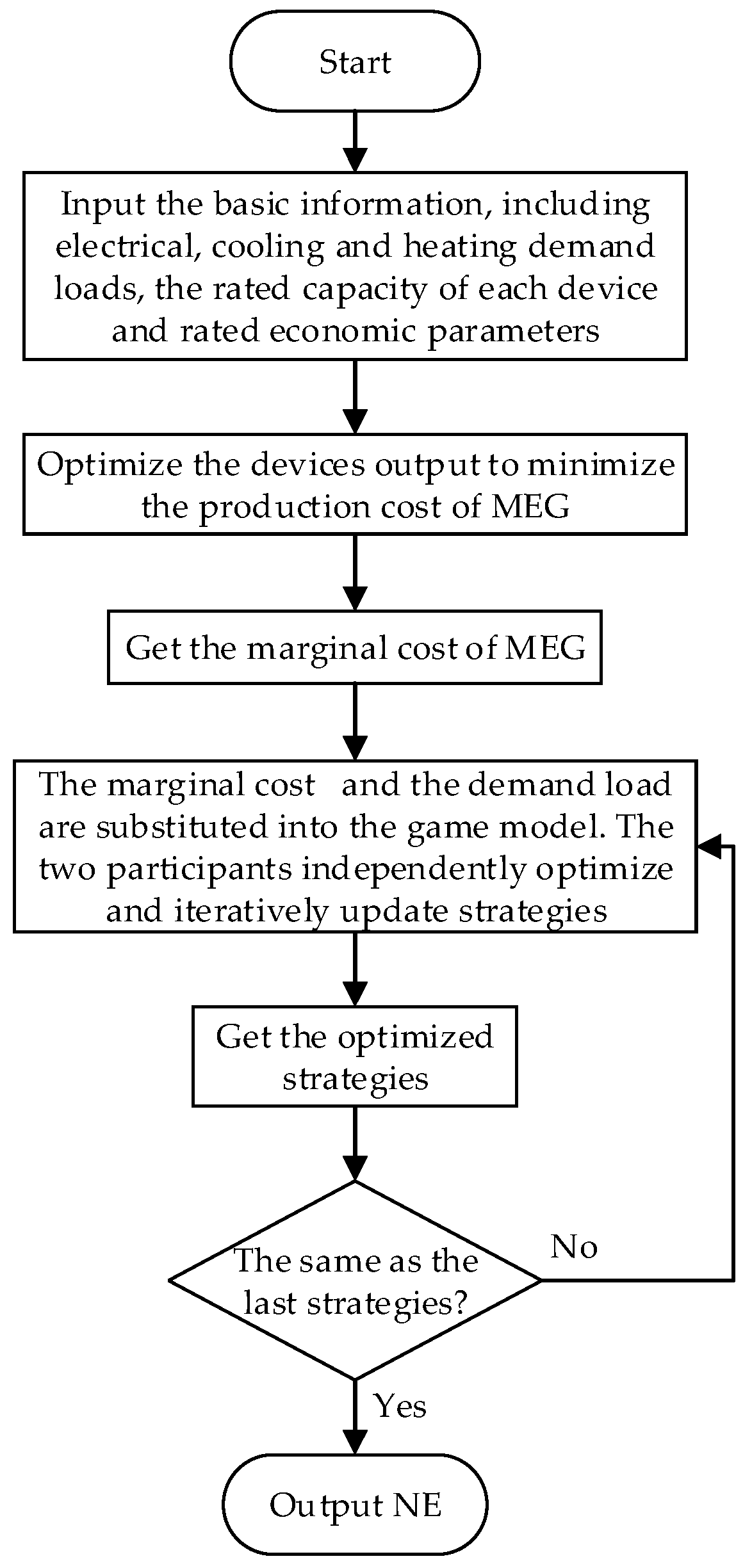
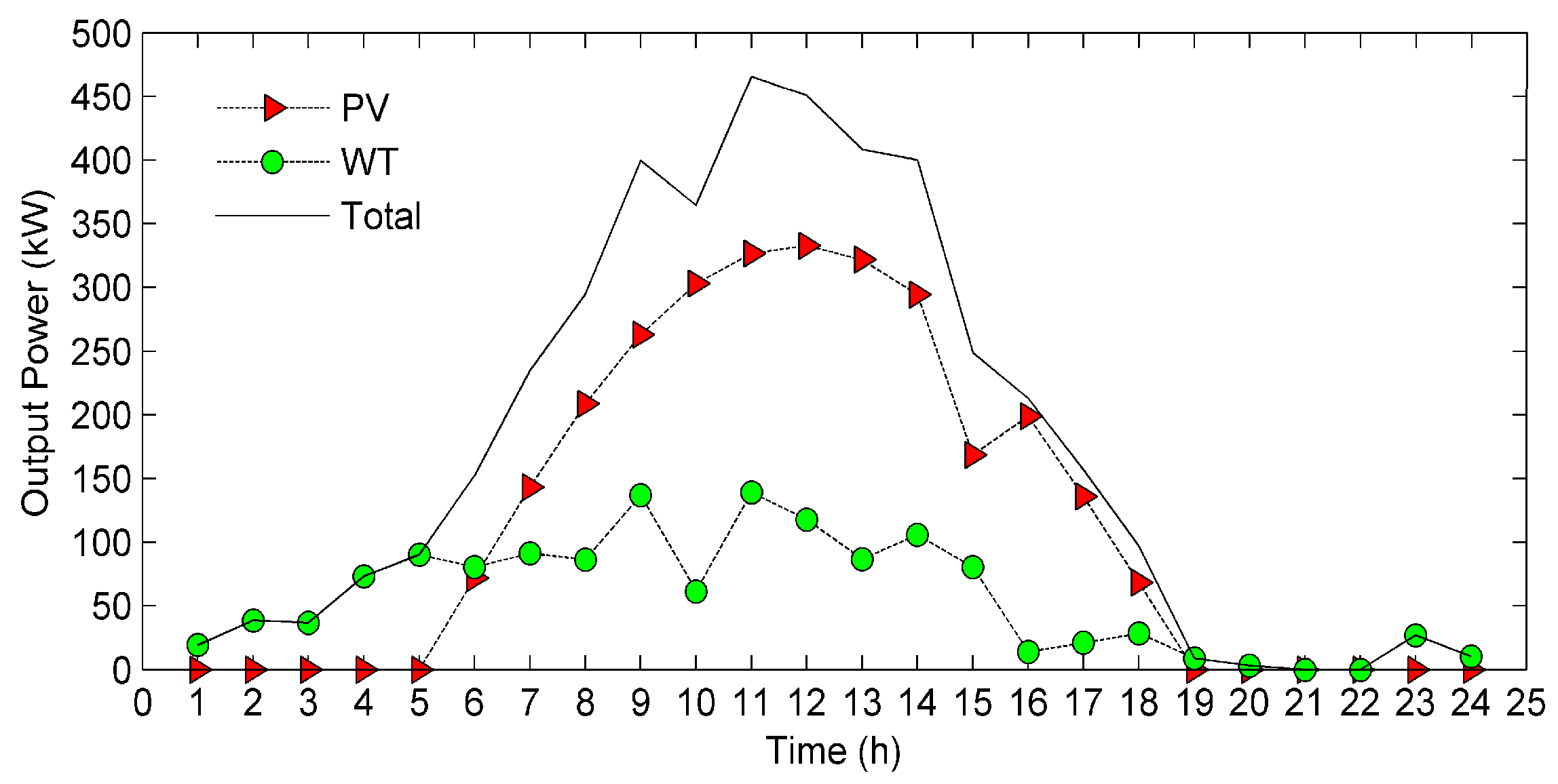
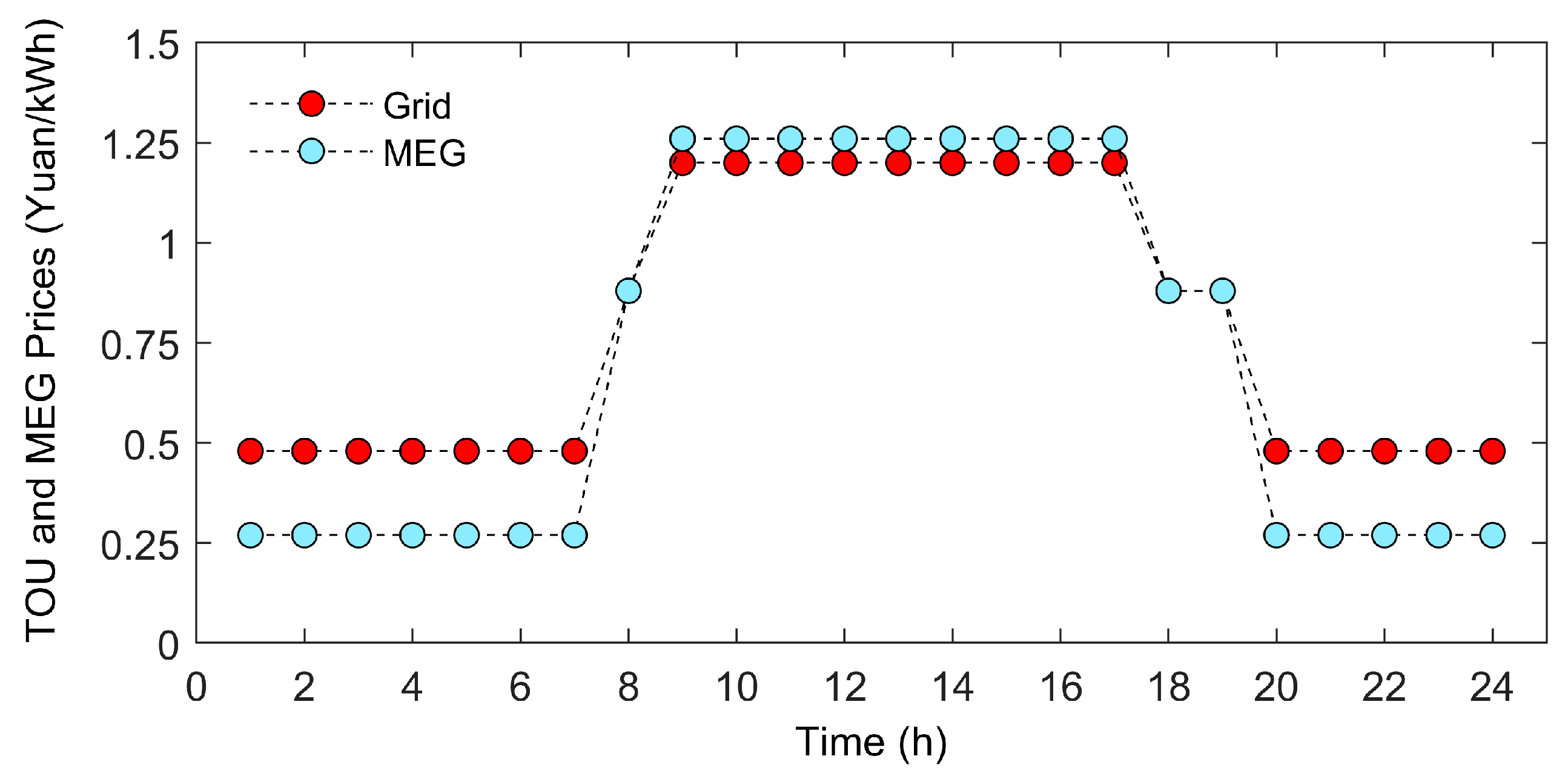

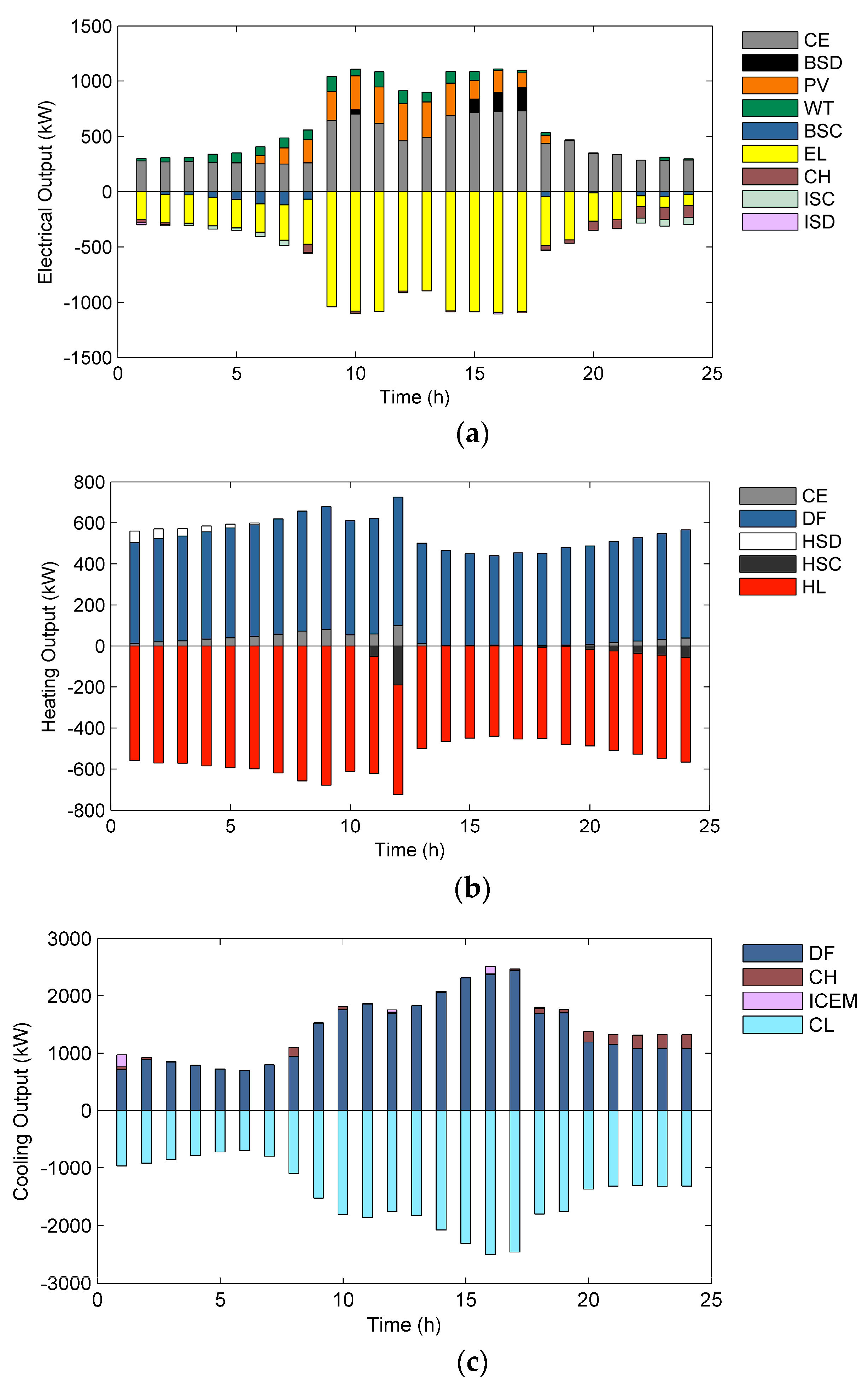
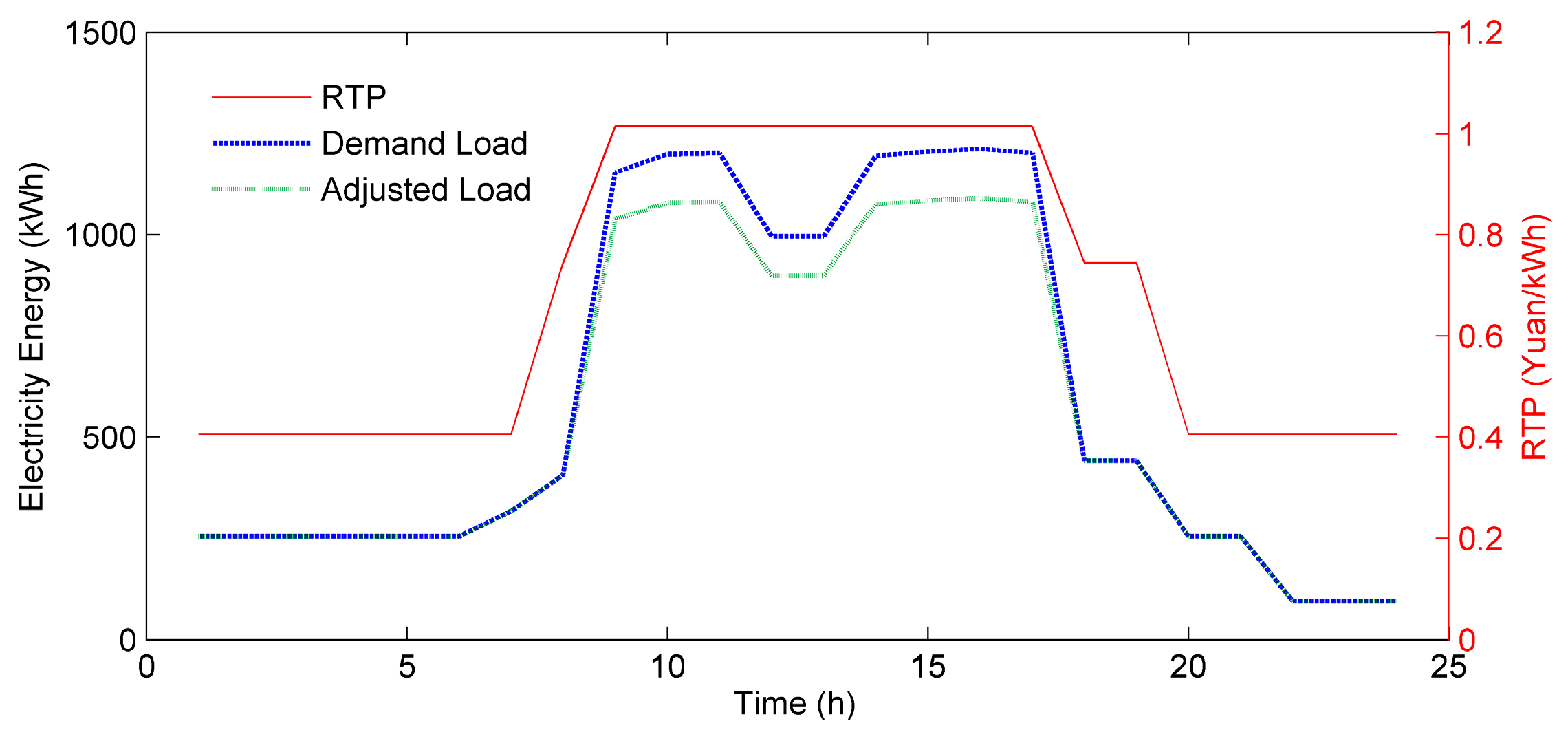
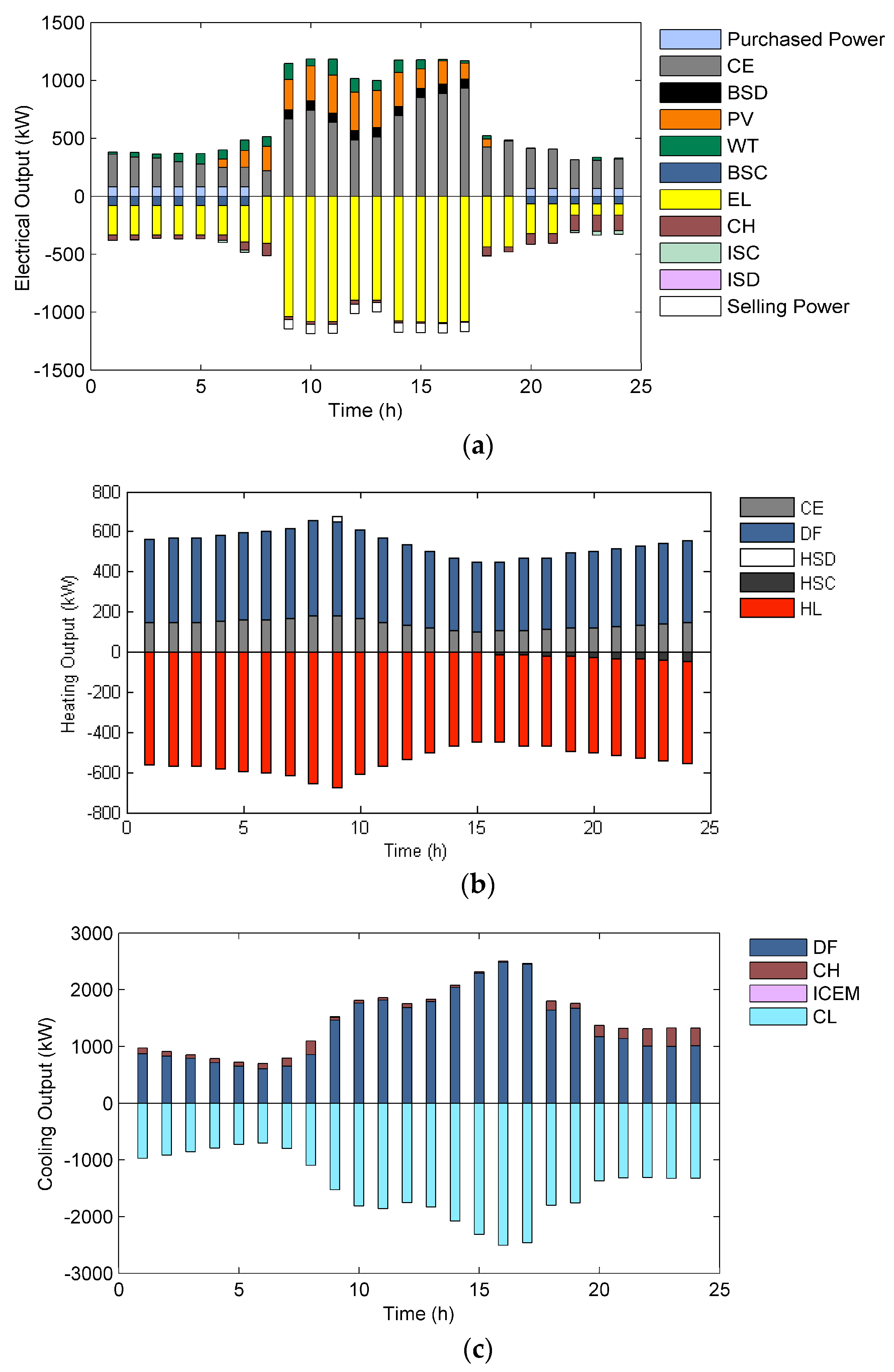
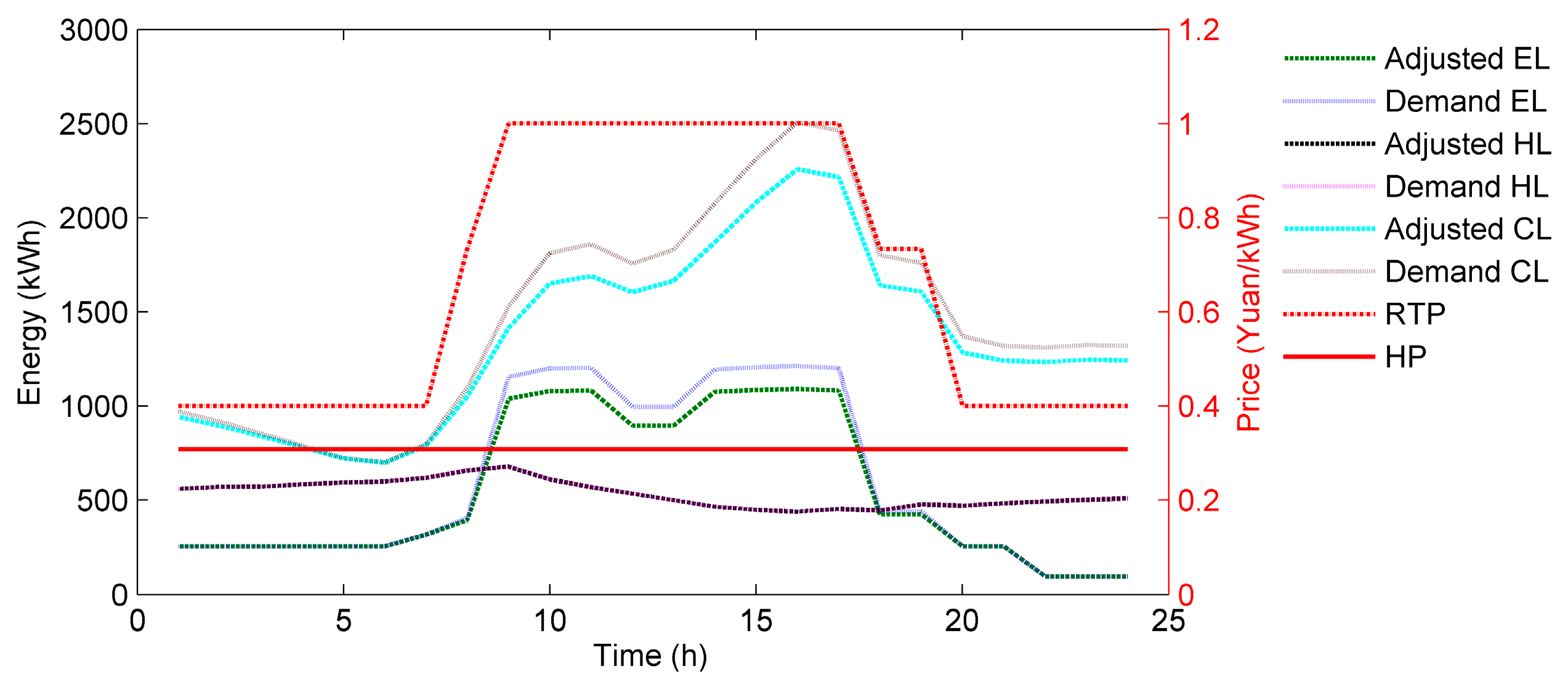

| PV | WT | CE |
| 400 kW | 150 kW | 1200 kW |
| CDF | HDF | CH |
| 1500 kW | 1000 kW | 1000 kW |
| Energy Storage Type | Capacity(kWh) | Maximum Charging Power (kW) | Maximum Discharging Power (kW) |
|---|---|---|---|
| Battery storage | 1000 | 200 | 300 |
| Thermal storage | 1000 | 200 | 300 |
| Ice tank | 1000 | 500 | 500 |
| Scenario | Production Cost of MEG (¥) | Profit of MEG (¥) | User Payment | User Expenditure (¥) |
|---|---|---|---|---|
| 1 | 12,398.08 | 10,530.81 | 0.2812 | 24,114.38 |
| 2 | 12,333.27 | 9156.51 | 0.4193 | 22,703.29 |
| 3 | 12,136.63 | 11,970.47 | 0.4598 | 25,306.61 |
© 2018 by the authors. Licensee MDPI, Basel, Switzerland. This article is an open access article distributed under the terms and conditions of the Creative Commons Attribution (CC BY) license (http://creativecommons.org/licenses/by/4.0/).
Share and Cite
Lin, K.; Wu, J.; Liu, D.; Li, D.; Gong, T. Energy Management of Combined Cooling, Heating and Power Micro Energy Grid Based on Leader-Follower Game Theory. Energies 2018, 11, 647. https://doi.org/10.3390/en11030647
Lin K, Wu J, Liu D, Li D, Gong T. Energy Management of Combined Cooling, Heating and Power Micro Energy Grid Based on Leader-Follower Game Theory. Energies. 2018; 11(3):647. https://doi.org/10.3390/en11030647
Chicago/Turabian StyleLin, Kaijun, Junyong Wu, Di Liu, Dezhi Li, and Taorong Gong. 2018. "Energy Management of Combined Cooling, Heating and Power Micro Energy Grid Based on Leader-Follower Game Theory" Energies 11, no. 3: 647. https://doi.org/10.3390/en11030647




